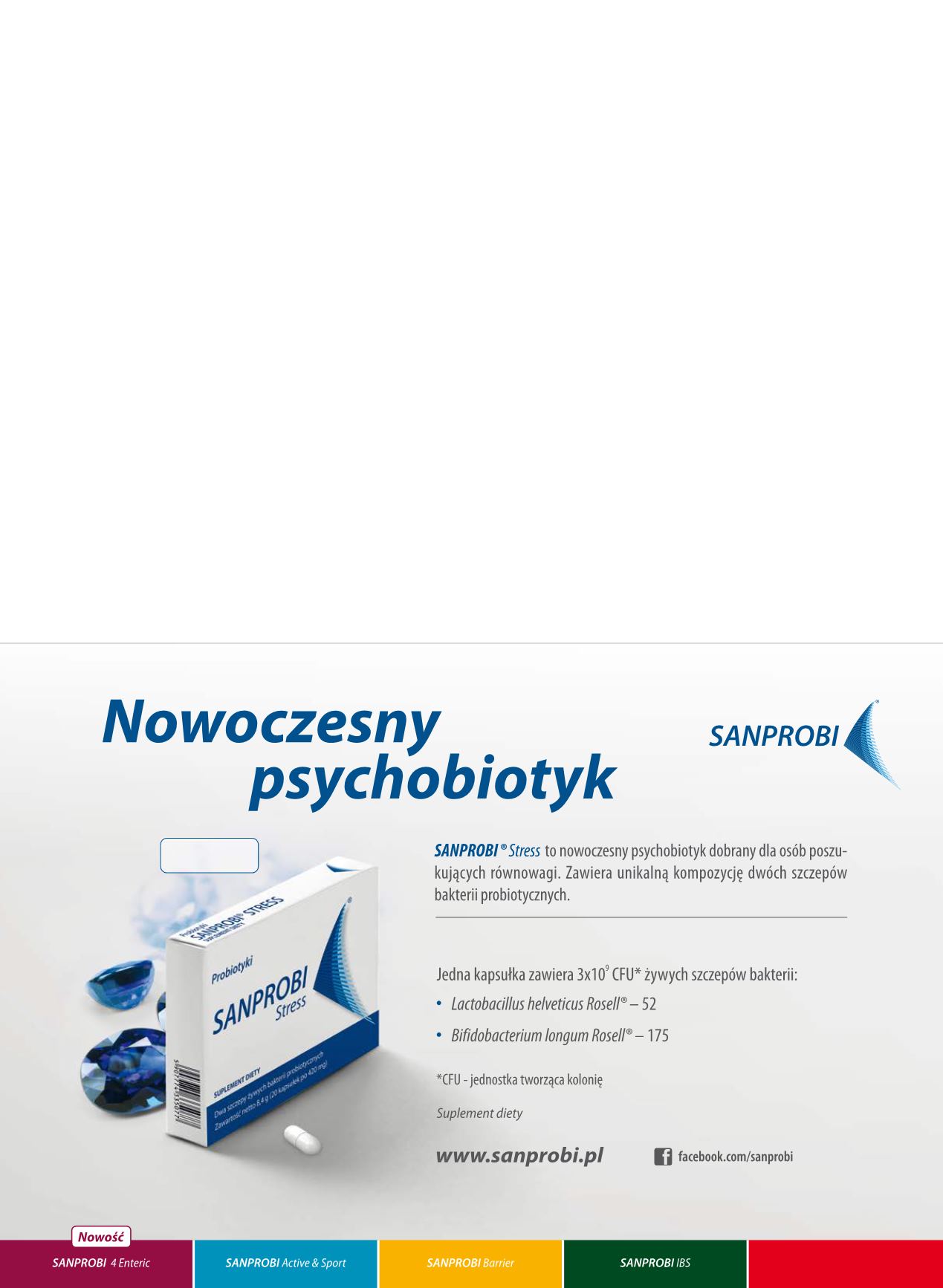
4 / 2019 / vol. 8
Kosmetologia Estetyczna
476
N
ARTYKUŁ NAUKOWY
PSYCHODERMATOLOGIA
LITERATURA
1.
Juszkiewicz-Borowiec M. Udział stresu w etiopatogenezie wybranych chorób skóry.
Przegląd Dermatologiczny, 1999, vol. 1(3): 61-65.
2.
Chen Y, Lyga J. Brain-Skin Connection: Stress, Inflammation and Skin Aging. In-
flammation and Allergy Drug Targets 2014, vol. 13(3): 177-190.
3.
Cohen S, Janicki-Deverts D, Miller GE. Psychological stress and disease. JAMA,
2007, vol. 298 (14): 1685-1687.
4.
Madison KC. Barrier function of the skin: “la raison d’etre” of the epidermis. J. In-
vest. Dermatol. 2003, vol. 121(2): 231-241.
5.
Slominski A, Pisarchik A, Tobin DJ, Mazurkiewicz JE, Wortsman J. Differential
expression of a cutaneous corticotropin-releasing hormone system. Endocrinology
2004, vol. 145(2): 941-950.
6.
Chen Y, Lyga J. Brain-Skin Connection: Stress, Inflammation and Skin Aging. In-
flamm Allergy Drug Targets 2014, vol. 13(3): 177-190.
7.
Arck PC, Slominski A, Theoharides TC, Peters E, Paus R. Neuroimmunology of
Stress: Skin Takes Center Stage. Journal of Investigative Dermatology 2006, vol.
126(8): 1697-1704.
8.
Liezmann C, Klapp B, Peters EM. Stress, atopy and allergy: a reevaluation from
a psychoneuroimmunologic perspective. Dermatol Endocrinol 2011, vol. 3: 37-40.
9.
Kunz-Ebrecht SR, Mohamed-Ali V, Feldman PJ, Kirschbaum C, Steptoe A. Cortisol
responses to mild psychological stress are inversely associated with proinflamma-
tory cytokines. Brain. Behav. Immun. 2003, vol. 17(5): 373-383.
10.
Slominski A, Wortsman J, Luger T, Paus R, Solomon S. Corticotropine leasing hor-
mone and proopiomelanocortin involvement in the cutaneous response to stress.
Physiol. Rev. 2000, vol. 80(3): 979-1020.
11.
McCarty R, Horwatt K, Konarska M. Chronic stress and sympathetic-adrenal me-
dullary responsiveness. Soc. Sci. Med. 1988, vol. 26(3): 333-341.
12.
Lee WJ, Jung HD, Lee HJ, Kim BS, Lee SJ. Influence of substance P on cultured
sebocytes, Arch Dermatol Res 2008, vol. 300(6), 311-316.
13.
ZouboulisC.Modernaspectsofacnepathogenesis.JDtschDermatolGes2010,vol.8:7-14.
14.
Makrantonaki E, Ganceviciene R, Zouboulis C. Anupdate on the role of the sebace-
ous gland in the pathogenesis of acne. Derm Endocrinol 2011, vol. 3: 41-49.
15.
Ganceviciene R, Bohm M, Kimmel S, Zouboulis C. The role of neuropeptides in the
multifactorial pathogenesis of acne vulgaris. Derm Endocrinol 2009, vol. 1: 170-176.
16.
Arndt J, Smith N, Tausk F. Stres a atopowe zapalenie skóry. Dermatologia po dyplo-
mie 2010, vol. 1(1): 9-16.
17.
Noszczyk M. Kosmetologia pielęgnacyjna i lekarska. Wyd. PZWL, Warszawa 2013.
18.
Hawryłkiewicz W, Wojnar E. Kosmetologia i Trądzik Pospolity. Indygo Zahir Media,
Wrocław 2012.
19.
Chiu A, Chon SY, Kimball AB. The response of skin disease to stress: changes in the
severity of acne vulgaris as affected by examination stress. Arch. Dermatol. 2003,
vol. 139(7): 897-900.
20.
Zouboulis CC, Böhm M. Neuroendocrine regulation of sebocytes: a pathogenetic
link betweenstress and acne. Exp Dermatol. 2004, vol. 13(4): 31-35.
21.
Lim DS, Bewley A, Oon HH. Psychological Profile of Patients with Psoriasis. Ann
Acad Med Singapore. 2018, vol. 47(12): 516-522.
22.
Kwon CW, Fried RG, Nousari Y, Ritchlin C, Tausk F. Psoriasis: Psychosomatic, soma-
topsychic, or both? Clin Dermatol. 2018, vol. 36(6): 698-703.
23.
O’Leary CJ, Creamer D, Higgins E, Weinman J. Perceived stress, stress attributions
and psychological distress in psoriasis. J. Psychosom. Res. 2004, vol. 57(5): 465-471.
24.
Verhoeven EW, Kraaimaat FW, Jong EM, Schalkwijk J, van de Kerkhof PC, Evers
AW. Effect of daily stressors on psoriasis: a prospective study. J. Invest. Dermatol.
2009, vol. 129(8): 2075-2077.
25.
Jabłońska S, Majewski S. Choroby skóry i choroby przenoszone drogą płciową. Wyd.
PZWL, Warszawa 2005.
26.
Arndt J, Smith N, Tausk F. Stres a atopowe zapalenie skóry. Dermatologia po dyplo-
mie 2010, vol. 1(1): 9-16.
27.
Bieber T. Atopic dermatitis. Ann. Dermatol. 2010, vol. 22(2): 125-137.
28.
Werfel T. The role of leukocytes keratinocytes and allergen-specific IgE in the deve-
lopment of atopic dermatitis. J. Invest. Dermatol. 2009, vol. 129(8): 1878-1891.
29.
Falay GT, Erdemir AV, Gurel MS, Kocyigit A, Guler EM, Erdil D. The investigation
of the relationships of demodex density with inflammatory response and oxidative
stress in rosacea. Arch Dermatol Res. 2018, vol. 310(9): 759-767.
30.
Orion E, Wolf R. Psychologic factors in the development of facial dermatoses. Clin
Dermatol. 2014, vol. 32(6): 763-766.
31.
KeriJ.What’snew inacneandrosacea?SeminCutanMedSurg.2016,vol.35(2):103-106.
32.
Jankowiak W. Stres a skóra. LNE 2018, vol. 118(3): 86-90.
Szczepy bakterii probiotycznych:
Nowość
Stress
Probiotyki
SANPROBI
Super Formula
SANPROBI STRESS 07.08.2019


